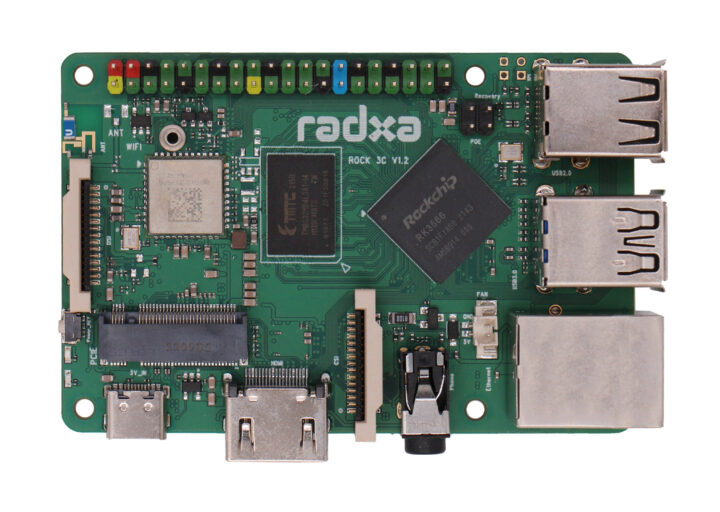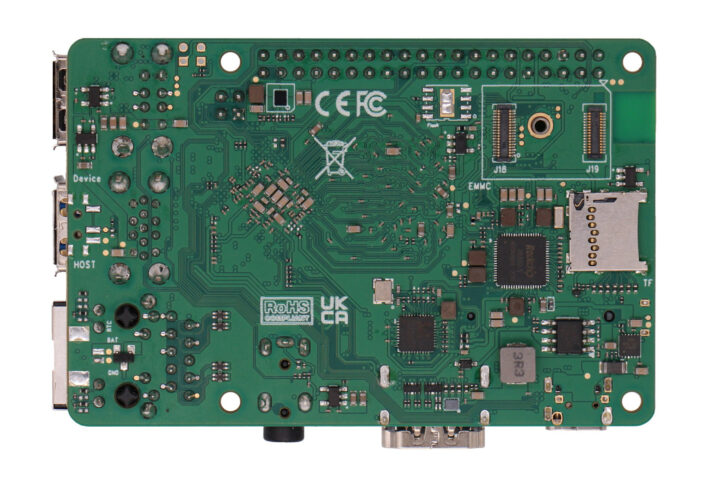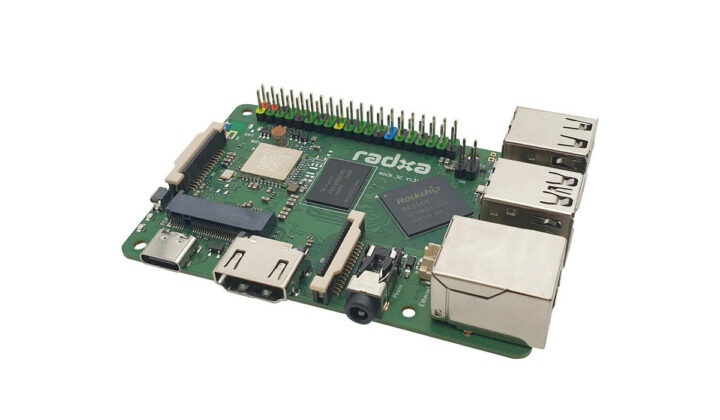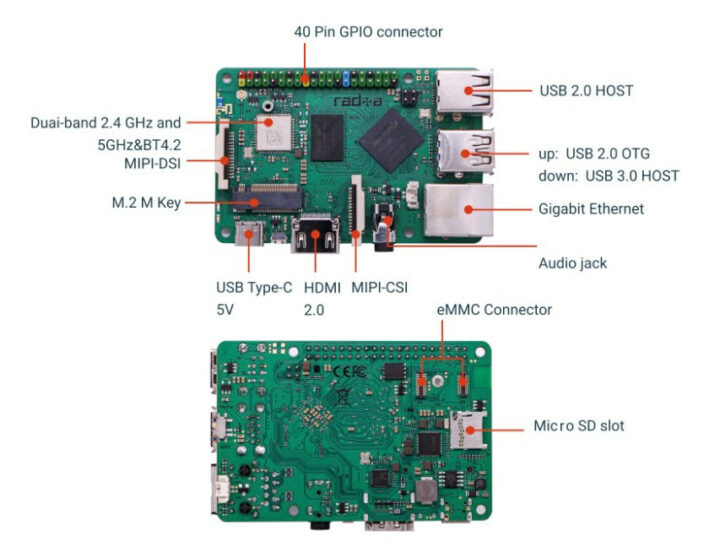Radxa ROCK 3C, also called ROCK 3 Model C, is a Rockchip RK3566-T Arm SBC with up to 8GB RAM and WiFi 5. It mostly follows the Raspberry Pi 3 Model B form factor, but also adds an M.2 PCIe socket for NVMe SSDs.
The single board computer also comes with a MicroSD card slot and eMMC flash module socket to boot the OS, a 4Kp60 capable HDMI 2.0 port, a MIPI DSI connector, a MIPI CSI camera connector, a 3.5mm jack with microphone, four USB ports, Gigabit Ethernet, and a 40-pin color-coded GPIO header.
ROCK 3C specifications:
- SoC – Rockchip RK3566-T quad-core Cortex-A55 processor @ 1.6 GHz with Arm Mali-G52 GPU, 0.8 TOPS NPU (AI accelerator)
- System Memory – 1GB, 2GB, 4GB, or 8GB LPDDR4 2112MT/s
- Storage
- MicroSD card slot
- eMMC module socket
- M.2 Key-M PCIe socket for 2230 NVMe SSD
- Video Output
- HDMI 2.0 up to 4Kp60
- 2-lane MIPI DSI connector
- Note: HDMI and MIPI DSI are multiplexed and cannot work at the same time.
- Audio – 3.5mm stereo audio jack with microphone support
- Camera I/F – 2-lane MIPI CSI input for up to 8MP cameras
- Networking
- Gigabit Ethernet RJ45 port with optional PoE support
- Dual 2.4GHz/5GHz WiFi 5 (802.11 a/b/g/n/ac) and Bluetooth 5.0
- USB –
- USB 2.0 OTG port (middle upper one) with hardware switch for host/device switch
- 1x USB 3.0 host port
- 2x USB 2.0 host ports
- Expansion
- 40-pin Raspberry Pi-compatible header with 2x I2C (up to 400 kbps), 1x SPI, 5x UART, 6x PWM, 1x ADC, 6x GPIO, 5V, 3.3V, and GND
- 1x M.2 PCIe socket for SSD
- Misc – Recovery button, 2x LEDs, RTC connector
- Power Supply
- 5V/3A via USB-C port, 5V/5A recommended when an SSD is connected
- PoE connector
- Dimensions – 85 x 56 mm (Raspberry Pi 3 Model B form factor)

 Radxa provides official images for Debian 11 and Ubuntu 20.04 Server, but Android 11 is not offered (yet). More technical details and instructions to get started can be found in the wiki.
Radxa provides official images for Debian 11 and Ubuntu 20.04 Server, but Android 11 is not offered (yet). More technical details and instructions to get started can be found in the wiki.
As one may have guessed, the ROCK 3C board is the third ROCK 3 SBC from Radxa, with the ROCK 3A having similar specifications and form factor but with a Rockchip RK3568 processor that enables dual display support and adding an M.2 Key-E for up to WiFi 6 wireless modules, and the upcoming ROCK 3B Pico-ITX SBC.
The Radxa ROCK 3C was optimized for cost, and the 1GB RAM model sells for $39 and the 2GB variant for $44 plus shipping, taxes, etc… The 4GB and 8GB RAM models are listed for $54 and $74 but are currently out of stock. The board is also showcased on the OKDO and Rockchip booths are the Embedded World 2023 conference.
Via LinuxGizmos.

Jean-Luc started CNX Software in 2010 as a part-time endeavor, before quitting his job as a software engineering manager, and starting to write daily news, and reviews full time later in 2011.
Support CNX Software! Donate via cryptocurrencies, become a Patron on Patreon, or purchase goods on Amazon or Aliexpress






